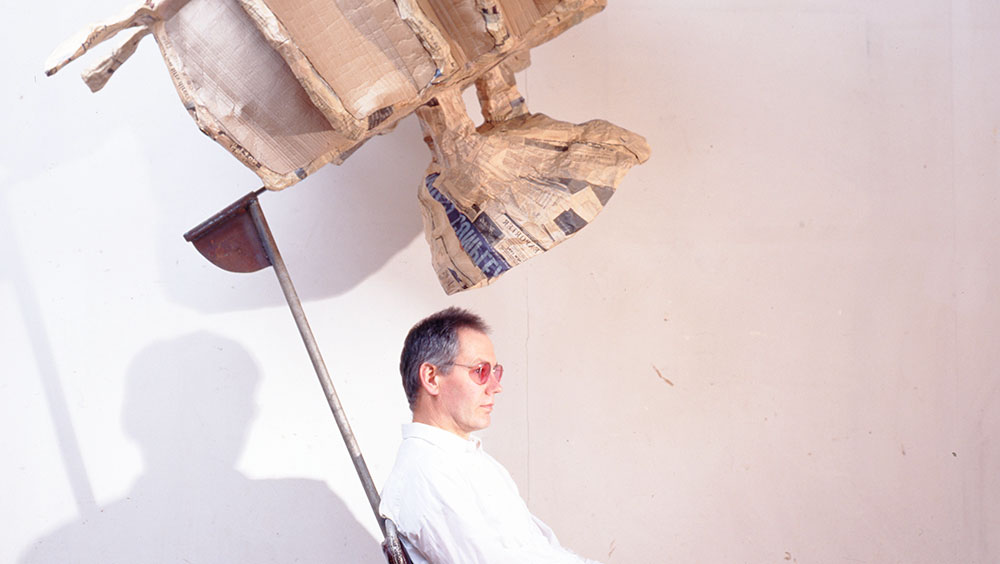
Nicholas Pope.
by VERONICA SIMPSON
Nicholas Pope has long been celebrated for his inventive, experimental and imaginative work in a multitude of materials. Born in 1949, in Sydney, Australia, and raised in the UK, in a 50-year career, he has made architectural ceramics, monumental carvings, knitted sculptures, flame-throwing statues representing leading biblical figures, architectural fantasies – including immersive installations in motorway service stations – and design prototypes. In all this work, whether drawing or sculpture, the pleasure of making is evident.
Pope studied ceramics and sculpture at Bath Academy of Art, Corsham, from 1970 to 1973. After a travelling scholarship to Romania in 1974 to 1975, he secured a place in the Hayward Gallery’s 1975 show The Condition of Sculpture and was recognised as part of a new wave of British sculptors whose work and style expressed more organic forms and themes, starting from a real physical and emotional engagement with materials. He was selected for the British Pavilion at the 1980 Venice Biennale, and the same year he showed across the US at the travelling exhibition British Art Now: An American Perspective.
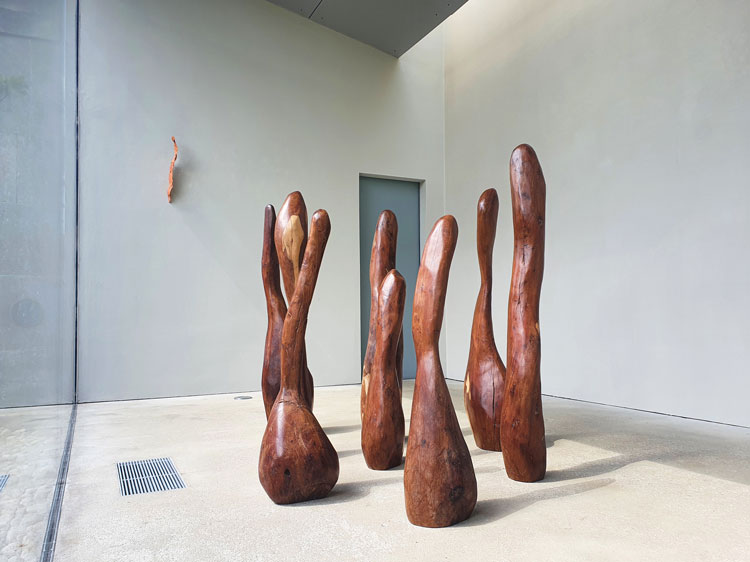
Nicholas Pope. Yews. Carved yews in eight parts, various dimensions, height 88-140 cm. © The Artist, Courtesy: New Art Centre, Wiltshire & The Sunday Painter.
Illness has been a major factor in the evolution – and arrest - of his practice. On a research trip to Tanzania in the early 1980s, to learn from the Makonde sculptors in the Ruvuma valley, he contracted viral encephalitis (inflammation of the brain), which forced him to spend several years in recuperation and to stop work altogether between 1987 and 1991. But his drawing and thinking continued. He made a triumphant return to the spotlight with his monumental multi-part sculpture The Apostles Speaking in Tongues Lit By Their Own Lamps (1993-96), which was shown at the Tate in 1996, marking a highly fertile period of work that has not abated, even with the more recent diagnosis of Parkinson’s.
This summer, Pope is celebrated in three major shows: Heavenly Space at the New Art Centre in Salisbury, Wiltshire; Portraits of a Marriage at the Holburne Museum in Bath; and Take Off, showing some of his earlier helmet sculptures and drawings and a new series of carpets, at The Sunday Painter in London.
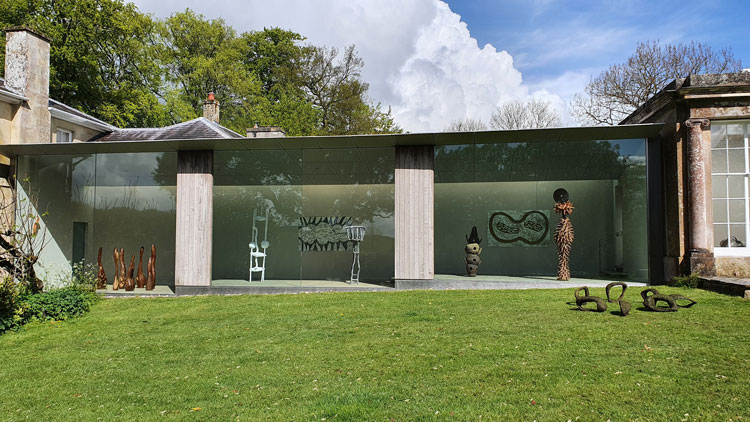
Nicholas Pope: Heavenly Space, installation view, the New Art Centre, Salisbury.
Veronica Simpson: There is such a wonderful diversity of styles and moods in the New Art Centre exhibition, from the restrained eloquence of your early Yews sculpture (1981) to the flamboyantly irreverent Apostles Piss Font (1995), or those Iron Holes (1978-2014), placed outside in that rolling landscape – all warped and wrinkled, as if weathered by centuries.
Nicholas Pope: The early work dates from when I was trying to find new ways of making sculpture, so I was at a point where I was a bit fed up with what I had made so far. I went to the Venice Biennale in 1980. And at the biennale I thought I didn’t have enough emotional interest in my sculpture. I saw that, at the German pavilion nextdoor to us, they had Georg Baselitz and Anselm Kiefer. And I had been aware of Francesco Clemente’s paintings and all those zeitgeist-y people. They were dealing with important issues and they were so much more exciting and difficult to pin down, so I started making drawings about what I wanted. That’s where Weird Sculpture (another piece at the New Art Centre) is from.
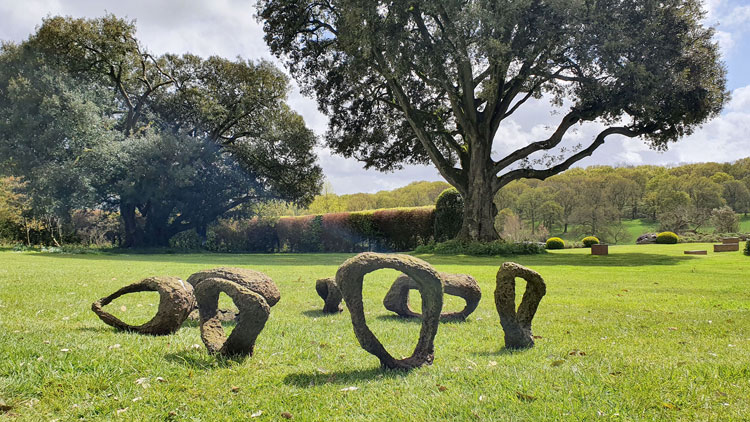
Nicholas Pope. Iron Holes, 1978-2014. Cast iron, seven parts, dimensions variable, maximum height 42 cm. © The Artist, Courtesy: New Art Centre, Wiltshire & The Sunday Painter.
VS: Is it satisfying as an artist to sit back and look at disparate works from all the different periods of your life?
NP: I reckon there are three phases to artist’s careers – the first effervescence, if they are lucky, then there’s the hard slog of 30 years or so, and then, if you get to the final phase, there’s an ease to it.
When we started planning these three exhibitions we wanted to try to explain to people why I make such disparate work. After 1980, it was because of the German pavilion and the zeitgeist painters and because I decided to find my own way. I went off to Tanzania to work alongside the Makonde carvers and learn about their specialism, which is to deal with their life history through abstract carving. That’s in a way what I do: express my personal history through abstract forms. But then also I got ill in Tanzania and that changed everything.
.jpg)
Nicholas Pope. Gold and White Shapes (A Conversation Snippet), 1985. Woodcut print on paper, 111 x 182 cm. © The Artist, Courtesy: New Art Centre, Wiltshire & The Sunday Painter.
VS: So each show is trying to express certain qualities, and clarify certain themes or periods. With the New Art Centre sculptures, I loved the fact that the ceramics seem to be much more fluid, feminine, playful forms and use crazy, clashing colours, while the metal, concrete pieces are more masculine, but also intensely tactile. Do certain materials for you correspond with particular moods or emotions?
NP: Certainly having experienced being ill and having stopped working and starting again, material became very important because I had to be able to manipulate it, and that in a way has opened up a response to material that is positive. And now I have Parkinson’s, and that is meant to heighten your awareness of colour. And I realise in this book of my drawings [Nicholas Pope: Drawings, published by Ridinghouse], that is an exact example of an artist getting Parkinson’s and becoming more colourful. The dates fit the drawings: you can flip through the book and it changes from black and white to any colour, anything that clashes, anything that’s awful, it’s all just wheelbarrowed in.
VS: Clay is also a wonderful recipient for colour, but it takes great skill to achieve those bright hues.
NP: Or you have to get Parkinson’s [laughs]. Yes, clay is important. When I applied to Bath Academy, I applied to do pottery because the only way I could do art at Charterhouse, the school I went to, was to go into the pottery rooms, because my housemaster said: “We don’t do art in this house.” And I really liked doing art, so ceramics was my base material, what I like using. It just flows off my fingers.
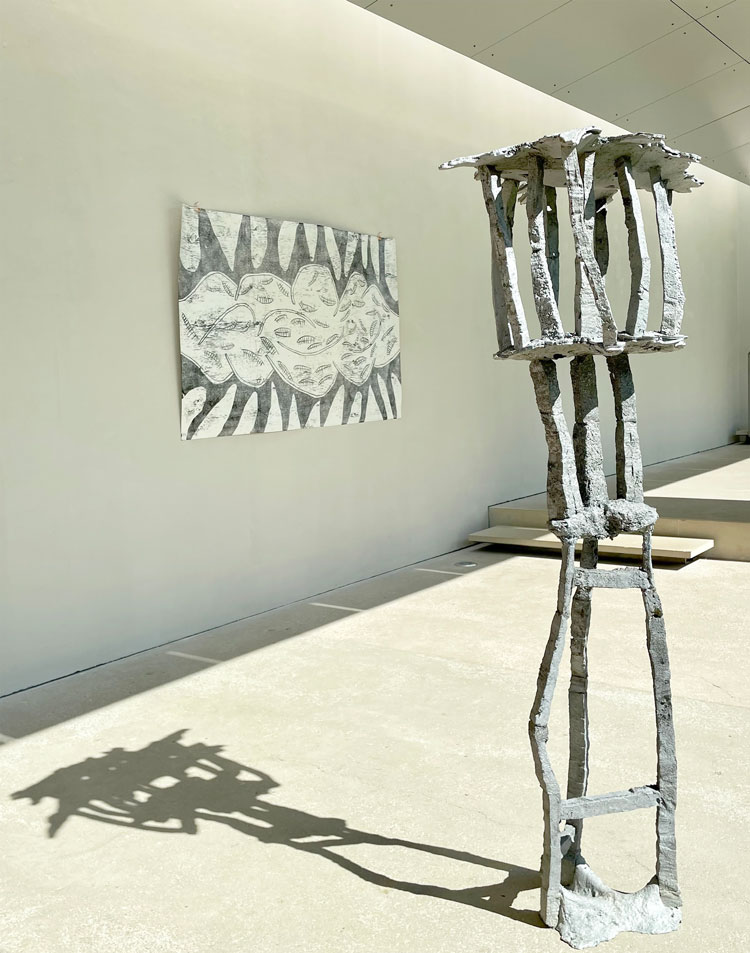
Nicholas Pope. Heavenly Space, 1991. Cast aluminium, 166 x 86 x 86 cm. © The Artist, Courtesy: New Art Centre, Wiltshire & The Sunday Painter.
VS: You seem to have dealt with your illnesses with immense courage. For all that these are horrendous life challenges, you appear to meet them with great resilience and have found new ways of making. Is it a case of, if you have limited resources, you make the best thing you can within those resources, and the things you want to say will find expression somehow?
NP: Yes. It has been that way. I think one just sort of deals with things. I’m trying to think of why I deal with what I do, what happens. My mother went to art school and she stopped going because of the war and became a dispatch rider. Her life then changed over the years and, when I was about 19, she was in a very bad car accident with my younger brother and I left during my final year at art school and went back to look after her, and came back afterwards to do my degree show. Life forces have always had to be dealt with.
It’s enormously interesting getting towards the end, and being aware of life and that life ends, and being pleased that I have managed to make work all the way through and it’s there, the difficult things you can’t change. You begin to see earlier work next to the old work and you can’t go back and make it any different. And that’s wonderful.
.jpg)
Nicholas Pope. Black Landscape (Mr and Mrs Pope Spiked and Holed), 1985. Woodcut print on paper, 163 x 130 cm. © The Artist, Courtesy: New Art Centre, Wiltshire & The Sunday Painter.
VS: Some artists are very careful to control the work that gets circulated, destroying anything they don’t think corresponds to their current work.
NP: Ah, but the crap often turns up in the good stuff. Certainly the drawings that I didn’t think were very good early on, like Weird, a drawing I made in the 80s, is pretty wacky, but it’s now going to be made into a sculpture that will float on the water of the duck pond at my friend Adam Munthe’s house, Hellens Manor (a Tudor Manor house), at Much Marcle. It is a terrific setting. They have a fine collection of paintings and they are going to build a new painting gallery around this duck pond and Weird is going to stand on the water and they’re going to have a biannual sculpture prize and set up something for sculpture down there.
VS: Much Marcle, in Herefordshire, is also where your studio is.
NP: We’re on the Marcle Ridge overlooking the Malvern Hills. Out of the window right now I just see Ledbury and the Malvern Hills above it. I have lived here for 40 years and it’s lovely.
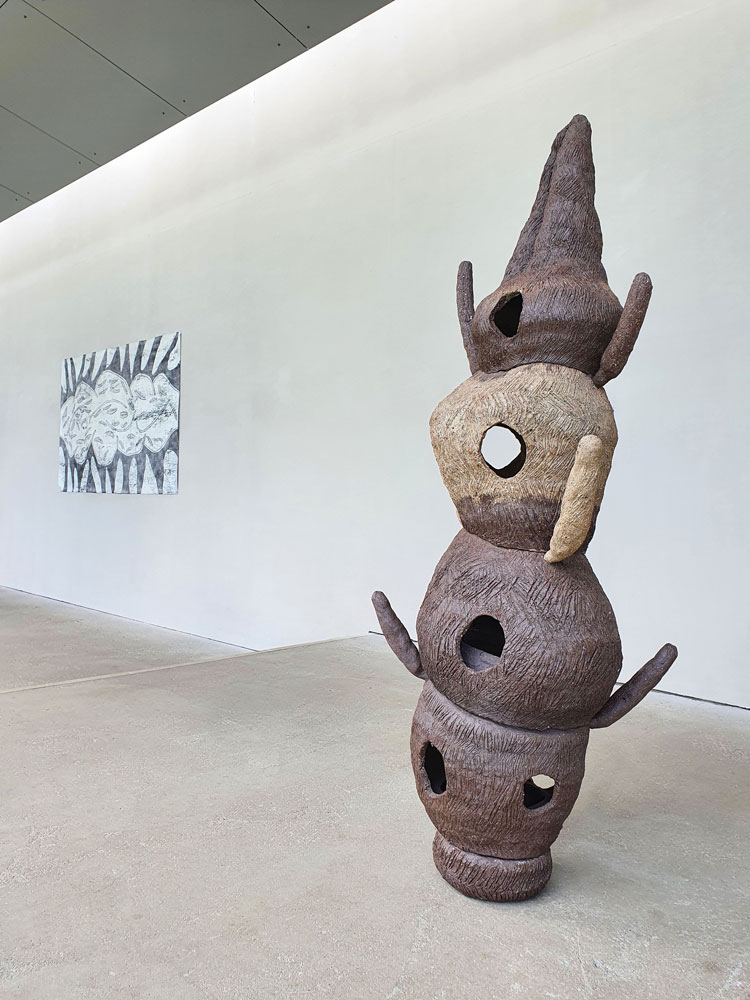
Nicholas Pope. Medium Weird, 2020. Fired stoneware, 142 x 45 x 36 cm. © The Artist, Courtesy: New Art Centre, Wiltshire & The Sunday Painter.
VS: There is another distinctive, mountainous landscape that has played a major part in your career: Romania. What drew you out there initially?
NP: Well, I didn’t apply to postgraduate colleges. I thought I might as well get making. What I did apply for was a travel grant from the British Council, and I heard that everyone applied to America and so, if you applied to a country where people didn’t want to go, you were more likely to get the grant. Also, we were all left wing in those days and it was still a communist country and I wanted to see it. So I went to Bucharest and had to learn the language and then I used to travel out and work with the craftsmen who made wooden spoons or roof tiles, or anything. I just wanted to get into the countryside among the hills of Romania.
VS: What did you come back with other than very fine wood carving skills? What aspects of their craft and culture assimilated into your practice?
NP: I learned that communism didn’t work [laughs]. I came back having met my wife, Janet, on a platform at Bucharest railway station. And I came back with an understanding of how people manage in difficult times, and an enormous debt of gratitude. I also wanted to see where (Constantin) Brâncuși came from and to just live the life of a peasant, really, because I had been rather comfortably brought up.
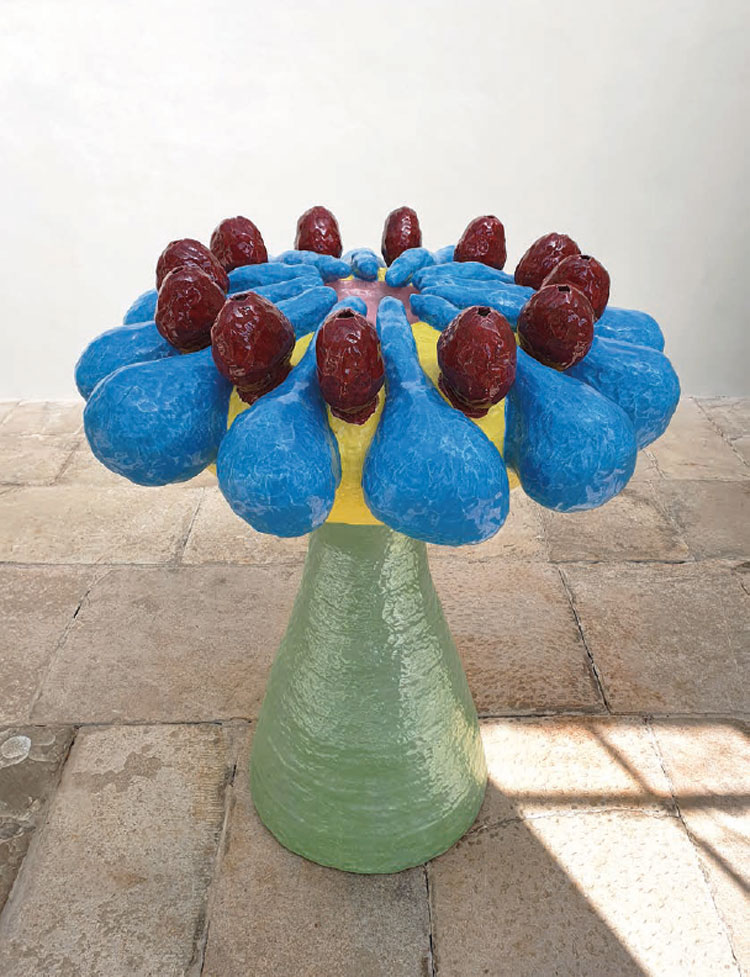
Nicholas Pope. Apostles Piss Font, 1995. Glazed ceramic, 116 x 91 x 91 cm. © The Artist, Courtesy: New Art Centre, Wiltshire & The Sunday Painter.
VS: Later, you travelled in Tanzania, which was followed by illness, but the work you did after Tanzania is characterised by your explorations of faith, religion and spirituality. I love the humour that you infuse in these works – such as the Apostles Piss Font (at the New Art Centre), which really made me laugh.
NP: I got into Pseuds Corner in Private Eye because I called an element of the Piss Font “clitoral florets”. What an accolade!
I talked earlier about dealing with subjects that are important, but I deal with them in a completely everyday manner and not as something important. They are important, but there’s a difference.
VS: Like The Apostles Speaking in Tongues, I wish I had seen that when it showed at Tate Britain (1996-97).
NP: The Apostles are a sculpture about the tongues of fire coming down from heaven and everybody in the crowd speaking in tongues, because they understood. That is a terrific explanation of what art can do. We artists can speak and everyone can understand in their own way what we’re speaking about. When I stopped work, I stopped making things, but I went on thinking about things, which is why the Apostles Speaking in Tongues was the first serious work I made after I recovered. If starting as an artist is difficult, trying to have a comeback after apparently failing is equally difficult. Doubly difficult. I decided I had to make a big work and really chuck all my thinking into it. And it turned out to be the Apostles Speaking in Tongues.
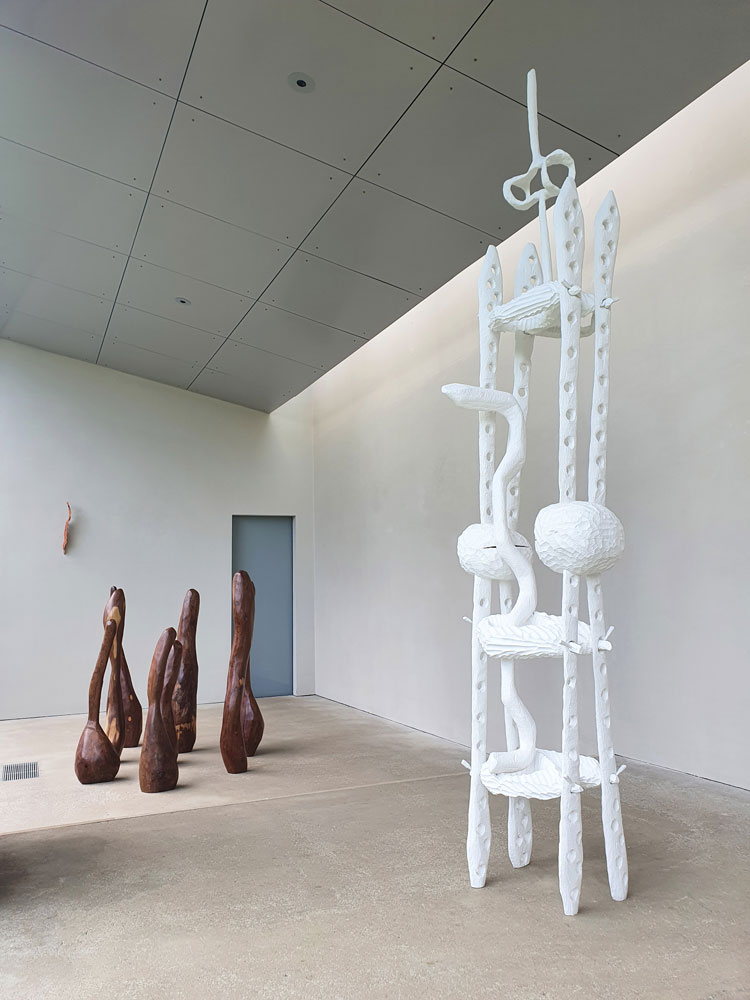
Nicholas Pope. The Vicar, 1997. Carved and painted wood, 280 x 60 x 54 cm. © The Artist, Courtesy: New Art Centre, Wiltshire & The Sunday Painter.
VS: Was there any negative reaction to the Apostles? Making work about religion had by then become seriously unfashionable.
NP: It’s a bit more fashionable now. It wasn’t fashionable then. I remember my friend John Hoole, who used to be curator at the Barbican, came and saw The Apostles, and said: “Nick, you can’t make work about this. It’s just not on.” [laughs]. I didn’t listen. And then Frances Morris (now Tate Modern director, then a curator) came to see them and gave me an exhibition at the Tate. So, it really paid off.
VS: You avoided making them too overtly figurative, but had a lot of fun with their characterisation.
NP: Yes, doubting Thomas has suction pipes in front of him. He sucks the blood from your hands; Judas is two-faced - slim from one side and wide from the other. And he is covered in lips. It took me three years to make that whole work.
VS: Tell me a little about the Holburne Museum show, which has 10 portraits you have made of yourself and Janet.
NP: One of the portraits of Janet and me - Mr And Mrs Pope - is knitted, which is something I used to enjoy doing in the evening. It’s knitted mohair that has been felted. The portraits are exhibited within the picture gallery with the Gainsboroughs and Stubbs and Constables on the walls. And we don’t do battle at all: we fit comfortably together. They look really nice together with these more formal portraits.
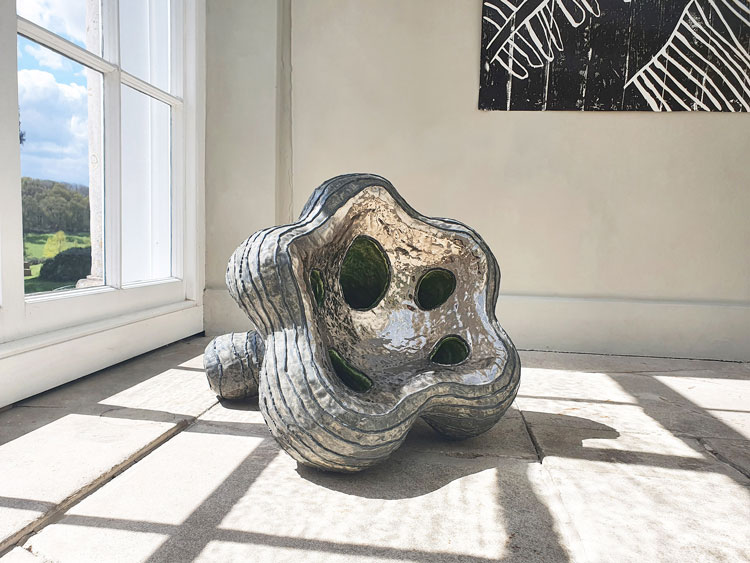
Nicholas Pope. Silver Washbasin, 2002. Glazed ceramic, 50 x 53 x 64 cm. © The Artist, Courtesy: New Art Centre, Wiltshire & The Sunday Painter.
VS: The most recent work on show is at The Sunday Painter, in Vauxhall, south-east London, where I believe you have made some rugs.
NP: The carpets are made from drawings. I’ve talked about Weird being for Hellens Manor. Hellens has a fair-trade cooperative that makes carpets in eastern Turkey. They are very beautiful. The carpets are absolutely top quality, hand-knotted. When working with craftsmen who make something for you, you have to absorb the abilities of the craftsmen, so they add something to it. So, for example, I’ve had glass blown for me, in making a sculpture called The Conundrum of the Chalices of the Seven Deadly Sins and Seven Virtues (2014). And, of course, I can’t blow glass at all, so I had to allow the craftsmen to do it slightly in their way. Though I haven’t been to Turkey, the cartoonist who works there is vital to interpreting my drawings. He makes them into digital cartoons on the computer, from which the carpet-makers work. That is beautifully done, too. They have added to my drawings, they have made them better, just as the glass-blowers made my glass better.
When I did the glass-blowing, I was asked to send some designs up to the National Glass Centre in Sunderland. Before I went up there to work, I sent two drawings. There was a silence from them, no response. So I got on the phone and they told me didn’t know how to respond. But by the end of the working period, they were actually using callipers to get the scale of the drawings correct. They had absorbed my drawings completely.
VS: Looking over this body of work, do you feel that you have gone some way towards seizing that Keifer-inspired initiative, to put added emotion and meaning into your work?
NP: Ha ha ha. That’s a really heavy question. That’s suggesting I might have solved the problem. There’s plenty more to do. I haven’t thought I’ve got to the end yet. The solution to the problem has always been to put more in. I shall continue wheelbarrowing stuff in.
• Nicholas Pope currently has two shows: Heavenly Space is at the New Art Centre, Salisbury, until 30 August 2021; Portraits of a Marriage is at the Holburne Museum, Bath, until 30 August 2021.